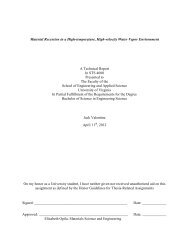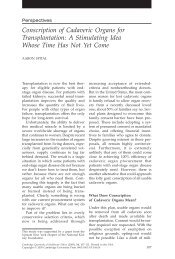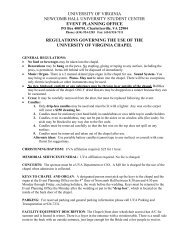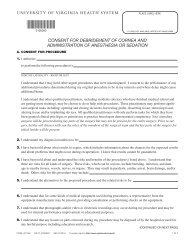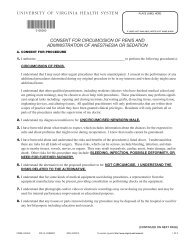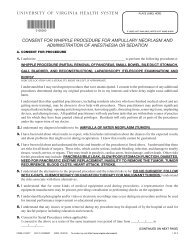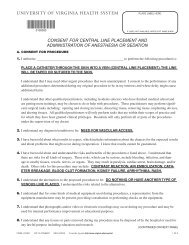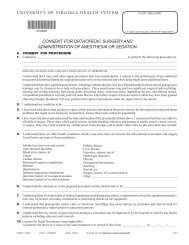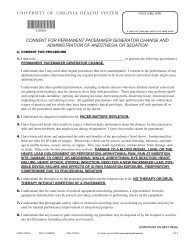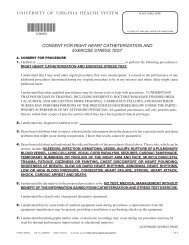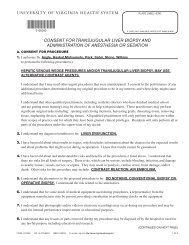Letter From Executive Vice President Leonard Sandridge (pdf)
Letter From Executive Vice President Leonard Sandridge (pdf)
Letter From Executive Vice President Leonard Sandridge (pdf)
Create successful ePaper yourself
Turn your PDF publications into a flip-book with our unique Google optimized e-Paper software.
P r e s i d e n t ’ s R e pF oI rNt<br />
A N C I A L R E P O R T<br />
Moving Forward with Confidence<br />
Report of the <strong>Executive</strong> <strong>Vice</strong> <strong>President</strong> and Chief Operating Officer<br />
This has been a productive year. Every member of this<br />
community—students and parents, faculty and staff, alumni<br />
and friends—can take pride in all the University of Virginia has<br />
achieved. The Board of Visitors and the management team<br />
worked effectively to launch groundbreaking initiatives that will<br />
provide for immediate needs and reap long-term benefits for<br />
the institution. Together we designed bold and innovative plans<br />
to meet the University’s objectives in major areas, including<br />
financial aid, compensation, and research support. The institution,<br />
under the leadership and strong encouragement of its<br />
board, has moved decisively to focus its resources in ways that<br />
bode well for the future of the University.<br />
RESTORING COMPENSATION LEVELS<br />
Recognizing that the University’s faculty and staff compensation<br />
has fallen relative to peers over the last decade, the board<br />
approved a resolution designed to restore faculty compensation<br />
to nationally competitive levels by the end of fiscal year 2007.<br />
The University’s goal is to achieve a ranking of between<br />
fifteenth and nineteenth in compensation among members of<br />
the Association of American Universities by 2006–2007. This<br />
is approximately the same position the University held in<br />
1989–1990, before the recent era of reduced state support.<br />
In November 2003, the board supplemented the state’s<br />
2.25 percent salary increases, the first in three years, with an<br />
additional 1.75 percent in targeted, merit-based raises for teaching<br />
faculty. As a result, the University jumped from thirtieth to<br />
twenty-fourth in the AAU rankings. For 2004–2005, the board<br />
authorized a 2 percent, merit-based salary increase for teaching<br />
and administrative faculty on top of a 3 percent raise approved<br />
by the Commonwealth. In addition, the board created a pool of<br />
funds for adjusting salaries of classified staff identified as undercompensated.<br />
These measures have significantly enhanced the<br />
University’s ability to recruit and retain talented faculty and<br />
staff. At the same time, steps have been taken to adjust compensation<br />
for Medical Center employees.<br />
<strong>Leonard</strong> W. <strong>Sandridge</strong><br />
BOLSTERING SCIENTIFIC RESEARCH<br />
Although grant funding for our sponsored research continues<br />
to grow from year to year, approaching $296 million in<br />
2003–2004, the University remains forty-fifth in federal funding<br />
among its peers for federal research and development expenditures.<br />
At the board’s request, Gene Block, the University’s vice<br />
president and provost, outlined an aggressive strategy to raise the<br />
stature of the University’s research programs in select areas of science,<br />
engineering, and medicine. In response, the board funded<br />
$60 million of a five-year, $126 million program to recruit worldclass<br />
investigators in key areas of research, to fund salaries for<br />
their research teams, and to build new research space. Two laboratory<br />
buildings are now in the planning stages, and we have<br />
begun our targeted hiring of internationally renowned faculty.<br />
RESULTS OF SOUND MANAGEMENT<br />
In a time of scarce resources, sustaining the University’s<br />
progress requires careful budgeting and management. In recent<br />
years, as we dealt with cutbacks in state support, we have taken<br />
the opportunity to streamline our operations. Now that a portion<br />
of these funds has been restored, we are reallocating dollars to<br />
U n i v e r s i t y o f V i r g i n i a<br />
38
F i n a n c i a l R e p o r t<br />
areas of highest priority where they<br />
will achieve the best results.<br />
Our commitment to careful<br />
management can be seen clearly in<br />
the Medical Center. Achieving an<br />
operating margin of 5.4 percent<br />
in 2003–2004, it surpassed the<br />
5 percent goal set by the Board of<br />
Visitors. This is the second year in<br />
a row that we have exceeded the<br />
board’s expectations; our results<br />
place us in the top 10 percent of<br />
academic medical centers. All<br />
income from the Medical Center is<br />
reinvested into our clinical operations,<br />
providing resources for new<br />
equipment, new medical technologies,<br />
or the renovation and expansion of our facilities.<br />
The endowment continues to be a tremendous source of<br />
strength. By June 30, 2004, our pooled endowment, the portion<br />
held directly by the Board of Visitors, had reached $1.95 billion.<br />
Adding funds held by University-related foundations brings the<br />
total endowment to $2.79 billion. Under the able stewardship<br />
of the University of Virginia Investment Management<br />
Company (UVIMCO), the pooled endowment achieved a 12.7<br />
percent return this past year, which is consistent with the returns<br />
we have experienced over the past decade. During this period,<br />
UVIMCO has been restructured to devote its full attention to<br />
asset management, and Christopher J. Brightman has been<br />
selected as chief executive officer of the management company.<br />
Our sound management, our strong endowment, our muchin-demand<br />
programs and services, and our generous support<br />
from alumni and friends, which reached nearly $175 million<br />
this past year, are all indicators of a thriving institution. They<br />
are among the key factors cited by Standard & Poor’s, Fitch<br />
Ratings, and Moody’s Investors Service in awarding us their<br />
top debt ratings. We remain one of only two public institutions<br />
to hold AAA ratings from all three credit-rating agencies.<br />
SUSTAINING EXCELLENCE IN EDUCATION<br />
For much of the past decade and a half, the<br />
Commonwealth of Virginia has struggled to provide adequate<br />
financial resources for its colleges and universities. In 1985,<br />
funding for higher education represented approximately 17 percent<br />
of the state’s general fund budget; by 2004, state appropriations<br />
for higher education fell to just 10 percent. This funding<br />
level ignores a nearly 17 percent increase in in-state students<br />
educated in the state’s system of higher education over the past<br />
fifteen years. Competing demands for state tax dollars will<br />
make it extremely difficult for the state to fund its colleges and<br />
universities at the level necessary to sustain their ranking as<br />
among the very best public institutions in the country.<br />
In an effort to support the high standards that Virginians<br />
have come to expect, the University has joined two other leading<br />
institutions—Virginia Tech and the College of William and<br />
Mary—to ask the General Assembly to create a mechanism for<br />
giving public universities and colleges more control over their<br />
operations. The initiative is open to all public institutions. The<br />
concept holds great promise in sustaining the premier system<br />
of higher education in Virginia and in supporting the important<br />
initiatives set forth by Governor Warner to enhance excellence<br />
in education throughout the state.<br />
Under the new model, U.Va.<br />
would forgo some potential for<br />
future growth of tax appropriations.<br />
In exchange, we would<br />
be given more administrative<br />
autonomy, including the ability to<br />
set tuition levels, and would be free<br />
to achieve operational efficiencies<br />
that will reduce costs and speed<br />
operations. If such a proposal is<br />
approved, there should be no doubt<br />
that the University will remain a<br />
strong public institution, living<br />
up to its historic commitment to<br />
educate Virginians and serve the<br />
people of the Commonwealth and<br />
the world.<br />
KEEPING COLLEGE AFFORDABLE<br />
Although we are proud of our reputation as an outstanding<br />
value in higher education, achieving greater self-reliance under<br />
a new relationship with the Commonwealth is likely to require<br />
increased costs for our students, both in-state and out-of-state.<br />
At the same time, we recognize that paying for college represents<br />
a significant burden for students from low- and middleincome<br />
families. Some must work long hours, devoting time that<br />
would otherwise be spent studying, taking part in independent<br />
research, or participating in student-life activities. Others leave<br />
the University with levels of debt that preclude entering careers<br />
in public service or attending graduate school. Furthermore,<br />
rising tuition costs deter highly qualified but financially disadvantaged<br />
students from seeking or accepting admission here.<br />
To address these issues, the Board of Visitors unveiled<br />
AccessUVA, an ambitious financial-aid program designed to keep<br />
the University experience within reach of all students who qualify<br />
for admission, regardless of economic circumstance.The board<br />
committed $17.9 million annually to this program, which will be<br />
rolled out over the next four years. Combining loan-free packages<br />
for low-income students, caps on loans for all other students qualifying<br />
for aid, and our commitment to meet 100 percent of need,<br />
AccessUVA stands as the most comprehensive program of its type<br />
at any public university.<br />
REMAINING TRUE TO OUR MISSION<br />
We have seen a time when our emphasis is on making this<br />
University the best it can possibly be. We have been unrelenting<br />
in our willingness to assess our performance and focus our<br />
resources in ways that distinguish this institution from most<br />
others. The predictably sound work that faculty and staff are<br />
doing on a day-to-day basis has given us the confidence to go<br />
forward. We stand at a crossroads with high expectations of<br />
future success that few places can enjoy.<br />
<strong>Leonard</strong> W. <strong>Sandridge</strong><br />
<strong>Executive</strong> <strong>Vice</strong> <strong>President</strong><br />
and Chief Operating Officer<br />
U n i v e r s i t y o f V i r g i n i a<br />
39



